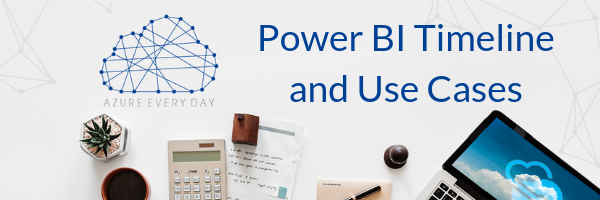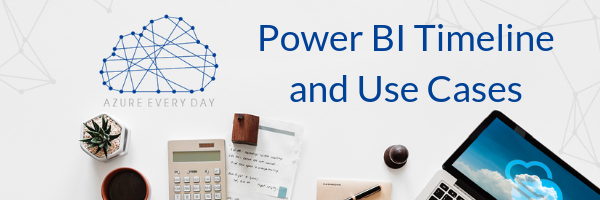Power BI Timeline and Use Cases


One of the challenges with Power BI is that there are so many ways it can be used and so many nuances that the platform may seem overwhelming to some. In this post, I’d like to share some mainstream, as well as specialized use cases.
First a little history of how Power BI came to be. Power BI is based on SQL Server Analysis Services which is over 20 years old. Although SSAS has been reinvented and modernized a few times, the point is it’s based on the foundation of a semantic data model that’s been around for a long time.
This technology graduated into Power Pivot for Excel in 2010 and as Power BI continued to grow up, we saw Power View (a great data visualization tool) and then Power Query and add ins for Excel. When these capabilities came together in Excel as add ins, it was the transition of Microsoft taking BI to the masses, to the business analyst user rather than just through IT channels.
Finally, in 2015 Power BI was released as both a desktop tool and a cloud-based service independent of Office 365, SharePoint and Excel, among other tools, which made it a rock-solid stand-alone tool and eventually a platform that is very capable and enterprise ready.
The data model is the foundation of Power BI reports. If you get the data model right, then reporting comes easy. When you think about the queries that you create, think of them as the legs that hold up that foundation; those are your data sources or how you connect to that data.
After we get acquired data through these queries, we build the data model and again, get the model right and the rest becomes easy and you can build report visuals on top of that data model. Unfortunately, data modeling is not always super easy to do, especially when you have complex problems to solve.
When I explain to clients what Power BI is, I start with mainstream use cases. Thinking back again, years ago we used Excel or reporting services over an Analysis Services data model. We’ve now graduated to Power BI report visuals with a Power BI data model, which is still based on Analysis Services. A lot of new features are going into data models created with Power BI rather than Analysis Services and this may provide everything customers need, except for larger solutions.
Let’s look more at the progression of Power BI and mainstream use cases:
- In 2017, dedicated capacity in the Power BI service was introduced.
- Incremental data refresh gave us the ability to partition the data, so you don’t have to refresh the entire data model every time you need to get new data.
- In 2018, Data Flows was introduced which meant a foundation for governed data managed in the Power BI Service where business users can build their own entities based on the common data model and we can manage all our business entities in one place within the cloud and integrate that with a lot of goodness in the Azure cloud ecosystem.
- The Power BI product team is working on new capabilities to make Power BI an enterprise ready, governed platform such as certified datasets and application lifecycle management features integrated into the Power BI Service.
Now let’s look at some features that not everyone will need or use:
- Direct query - connect to data sources without importing and caching that data in the data model.
- Custom visual development – create your own visuals using the custom visual tool kit and there is lots of starting code available from Microsoft in GitHub.
- Streaming datasets –can programmatically stream data to a Power BI dashboard, so that we can see data change in real time.
- Application embedding – allows us to embed Power BI visuals, reports and dashboards into a custom web application as part of the custom solution.
- R and Python –R and Python allow us to perform true data science and to some degree, machine learning and AI integrated into Power BI.
- Composite models and aggregations – paired with direct query, these give us the ability to maintain some connections that use direct query and maintain other connections to tables that import data together to form composite models where these tables can be related to each other. We can also create aggregations over the top of direct query tables that cache aggregate result sets.
- Machine learning in cognitive services and other artificial intelligence capabilities are now integrated into Power BI Premium and surface through the common data service. There’s a whole spectrum of capabilities here like black box cognitive services which provide things like text recognition, translations, face and object detection and then correlations, predictions and other advanced AI features.
Hopefully I’ve provided a reference point to understand both the mainstream and specialized use cases in the Power BI platform as it continues to move forward at a fast pace. We are passionate about Power BI and what it can do for your business. And with our Power BI Managed Services we will manage and monitor your entire Power BI ecosystem, so you can achieve your data-driven potential without the management hassle.
To learn more about Power BI or our Power BI Managed Services, click the link below or contact us—we’d love to help.
Sign-up now and get instant access

Free Community Plan
On-demand learning
Most Recent
private training






-1.png)
Leave a comment